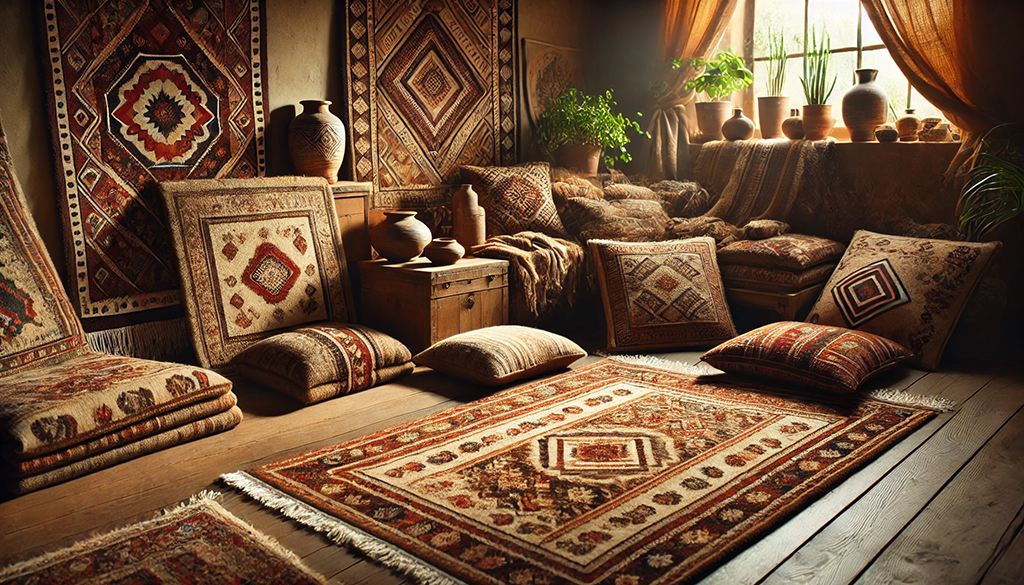

Lori and Gabeh rugs are more than just floor coverings; they are woven masterpieces that tell a story, rich in history, culture, and craftsmanship. Originating from the nomadic tribes of Persia, particularly from the Lori and Qashqai peoples, these rugs stand out in the world of Persian carpets for their simplicity, rustic beauty, and distinctive artistic charm. But what truly sets Lori/Gabeh rugs apart? Let’s unravel the secrets behind their uniqueness.
Lori and Gabeh rugs are steeped in the traditions of nomadic tribes from southwestern Iran. Lori rugs, made by the Lori people, and Gabeh (or Gabbeh) rugs, commonly associated with the Qashqai tribe, have been hand-woven for centuries by these tribespeople who led migratory lives. Each rug reflects the lifestyle and environment of its weavers, making every piece a cultural artifact as well as a functional object.
The Lori and Qashqai tribes, traditionally shepherds, used wool from their flocks to create these rugs. This connection to nature is an essential characteristic of Lori/Gabeh rugs, as the materials and designs draw directly from their surroundings—earthy tones, landscapes, and wildlife motifs.
One of the standout features of Lori and Gabeh rugs is the use of high-quality, hand-spun wool. This wool is typically left in its natural color or dyed with organic, vegetable-based dyes, giving the rugs a soft, muted palette that evokes the rugged beauty of their landscapes.
The thickness of the wool and the long pile are distinctive in Gabeh rugs, creating a plush texture that feels luxurious underfoot. This thickness, combined with the durability of wool, makes these rugs not only aesthetically pleasing but also highly functional. They are known for their durability and warmth, ideal for both practical use and artistic display.
Unlike the intricate, highly detailed designs often associated with Persian rugs, Lori and Gabeh rugs are known for their simplicity and boldness. This is where their charm truly lies.
Gabeh rugs are often described as primitive in their design, but this simplicity is intentional and profound. The weavers—mostly women—imbue each rug with personal creativity and symbolism, drawing on their daily experiences and surroundings. Geometric patterns, abstract forms, and animal figures like goats, camels, and birds are common motifs, offering a snapshot into the weaver’s world. There is an almost childlike playfulness in the designs, which lends Gabeh rugs their distinctive appeal.
One of the most recognizable features of Gabeh rugs is their irregular, asymmetrical patterns. This is a result of the freehand, spontaneous approach taken by the weavers, who are not bound by rigid design templates. This gives each rug a one-of-a-kind, artisanal feel.
Lori rugs, on the other hand, are more tribal and geometric in nature. Their designs feature bold shapes, often diamonds and medallions, with a strong sense of symmetry. The colors used in Lori rugs are typically darker and more subdued, reflecting the earthy tones of the natural world around the weavers. These rugs, too, carry deep symbolism, with each pattern or motif having cultural significance—whether it’s representing protection, prosperity, or nature.
The craftsmanship behind Lori and Gabeh rugs is nothing short of impressive. Both types of rugs are hand-knotted, a labor-intensive process that can take weeks or even months depending on the size and complexity of the rug. This traditional weaving method, passed down through generations, is what gives these rugs their high quality and lasting durability.
Lori and Gabeh weavers use a coarse knotting technique, which contributes to the rugged and textured feel of the rugs. Gabeh rugs, in particular, are knotted more loosely, which results in their thicker pile and plush finish. Lori rugs, while also thick, tend to have a tighter weave, making them denser and sometimes more detailed in pattern.
The colors in Lori and Gabeh rugs are another key element that sets them apart. Because these rugs are dyed using natural, vegetable-based dyes, they have an earthy, organic quality. The color palette usually consists of browns, creams, reds, and blues, which age beautifully over time, developing a patina that adds to the rug’s character.
The unpredictability of natural dyes also contributes to the unique look of each rug. Subtle variations in color, known as abrash, occur due to the hand-dyeing process, giving the rug a dynamic and layered appearance. This slight color variation is highly valued by collectors, as it showcases the authentic, handmade nature of the rug.
One of the most compelling reasons to invest in a Lori or Gabeh rug is their duality—they are both functional and artistic. These rugs are made to be used, but they are also deeply personal works of art. Whether placed in a cozy living room, a bedroom, or even on a wall as a tapestry, a Lori or Gabeh rug adds a touch of warmth, history, and sophistication to any space.
Their ability to adapt to modern and traditional interiors alike makes them incredibly versatile. Whether your style leans toward minimalist, bohemian, or eclectic, a Lori or Gabeh rug can enhance the space with its unique blend of simplicity and cultural richness.